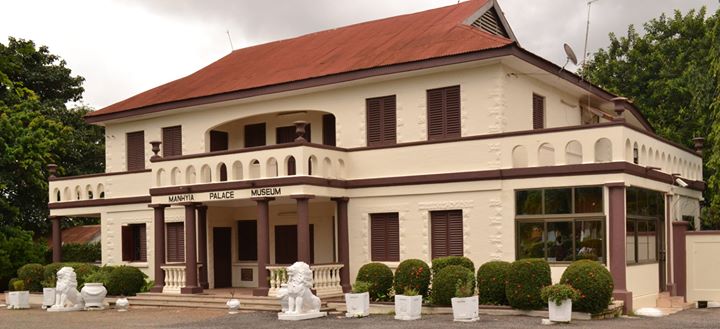Manhiya Palace Museum is a distinctive structure in West Africa. It was constructed in 1925 as a private home by the British Colonial Government for Asantehene Agyeman Prempeh I after he came back from his exile in Seychelles. The Asante Kingdom constructed this museum to honour all their leaders.
The Manhyia Palace Museum was formally opened by the 15th King of Asante, Otumfuo Opoku Ware II, on August 12, 1995. The opening event represented the Silver Jubilee of the Otumfuo Opoku’s accession to Asikadwa (the Gold Stool). The Museum was constructed in two phases, and it features open verandas as a yard. A small outdoor privy was later constructed in 1995 to serve as the Museum Shop.
The Manhiya Palace Museum signifies the riches of the history and culture of the Asante Kingdom to all future generations and visitors. Although the Museum is somehow small, it carries a lot of history and therefore visiting it is a worthy experience.
The Manhiya Palace Museum has great significance and relevance to the people of Ghana, it carries a lot of valuable items like Photographs, furniture, royal regalia, palanquins, and drums. Most of these valuables are more than two hundred years, for instance, the battle clothing was made in the 19th century. The other objects that are old in this museum are the dolls of all the retired kings, such as Nana Prempeh I, Nana Akyaa, Nana Yaa Asantewaa, Queen of Ejisu are still in the Palace and the present-day occupant of the Golden Stool.
The are various videos recorded to narrate the history of Asante and the its great culture. The videos are presented to the tourists to watch whenever they visit of this Manhiya Palace Museum for the first time. There are numerous samples of the gold-work such as gold weights, bracelets and pots for gold dust related to the Asante community. These gold-works are internationally recognized. In 1896, Lord Baden Powell, the Boy Scouts Movement founder, transferred the gold works from the palace.
The Manhyia Palace Museum was constructed next to the ancient homes of the thirteenth and Fourteenth Kings of the Asante Community. In 1995 the structure was transformed into a museum. The price of transforming this building was contributed by friends and supporters of Asanteman and the King.
Also read: The Fascinating Accra Zoo is Worth a Visit
The ground floor of the Manhyia Palace Museum still looks like it was during the era of Otumfuo Agyeman Prempeh II. This floor is the lasting memorial to late Otumfuo and long service to the Asante Nation. Additionally, there are many pictures of the various significant events in Asante history. Other essential features include the first black and white Television of Asante Nation, which was introduced in 1965, the bronze head of Nana Prempeh II, a books shelf comprising a collection of books used by the kings and a draft Map of the Asante Empire.
Manhyia Palace Museum has various well-trained tour guides who are fully prepared to take all the tourists through the history and any other thing that tourists may require to know about the Asante Kingdom. The tour guides understand everything concerning the Asante Community, and therefore, they usually respond to all the tourists’ questions accurately and correctly. In the company of the guides, you learn all the history and culture of the Ashanti Kingdom, the royal families, rites, and the struggle with the British Colonial army.
The Museum is well accessible via private or public transport. There are restaurants where you can get traditional dishes prepared by the locals. Besides, there are sufficient accommodations around this prominent museum where tourists can spend their nights in case it is late to go home.
Around the Museum has excellent gift shops where tourists can buy local Asante Items. The products from these shops are very quality and of affordable prices. Most of the items are related to the culture of this great community.
